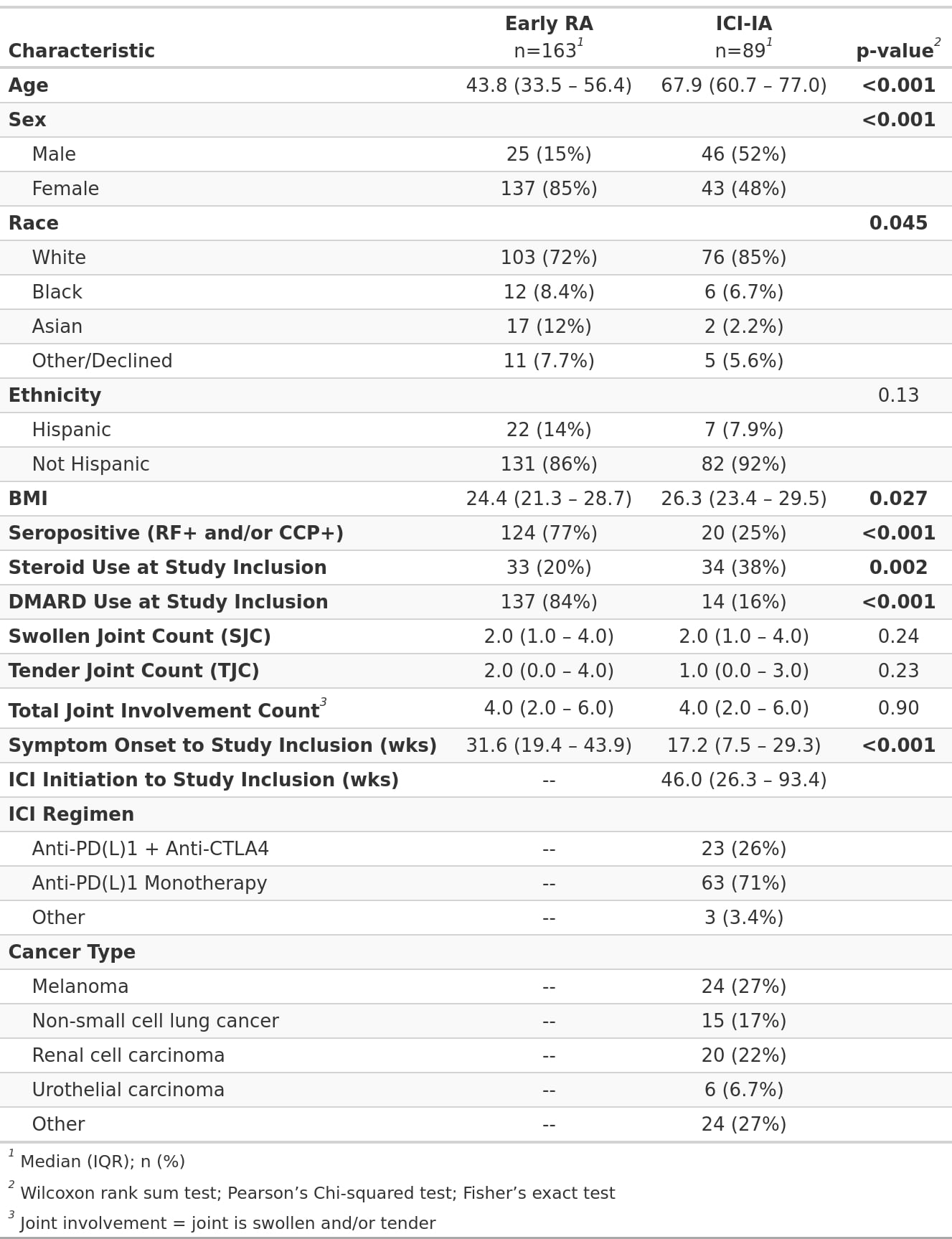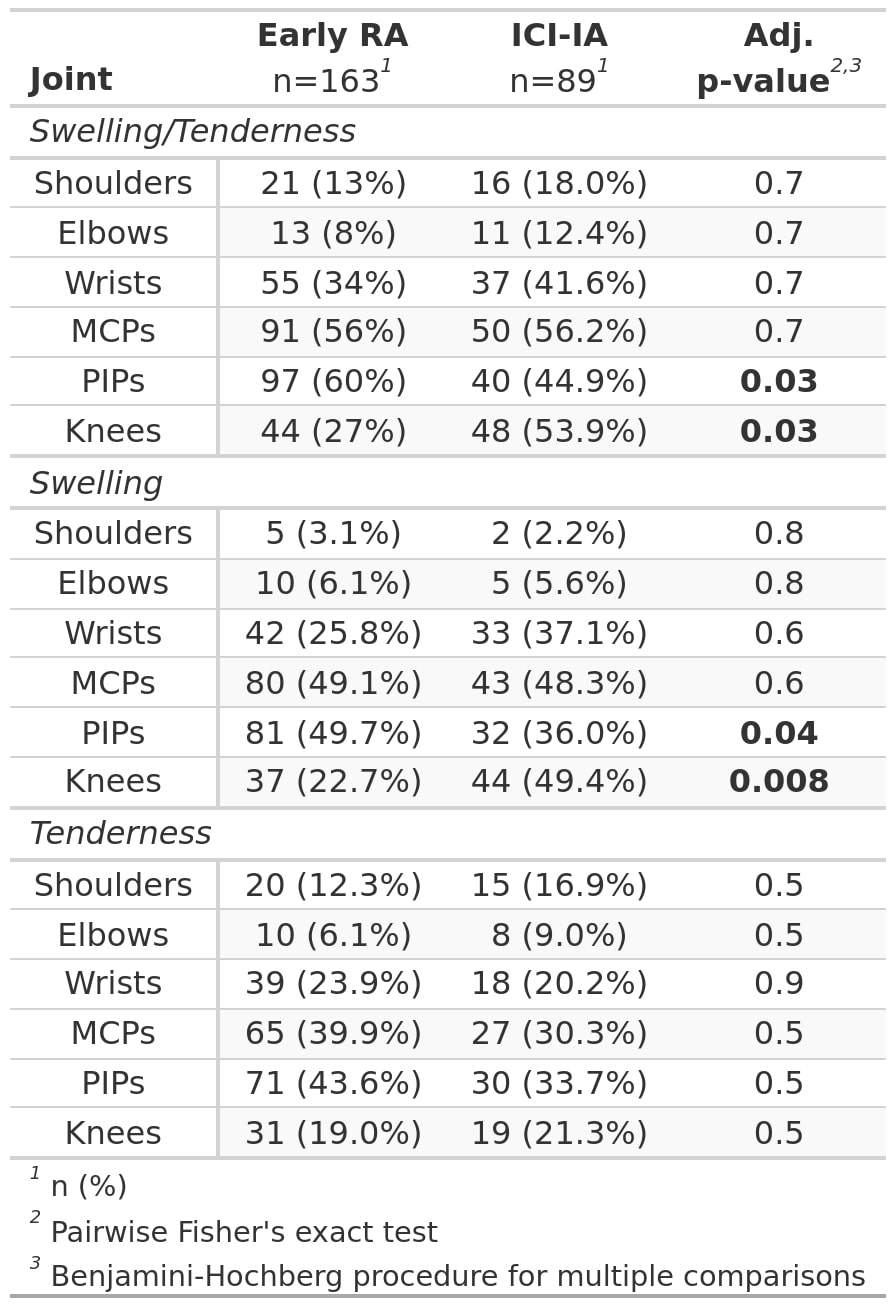Session Information
Date: Monday, November 13, 2023
Title: (1052–1081) Immunological Complications of Medical Therapy Poster
Session Type: Poster Session B
Session Time: 9:00AM-11:00AM
Background/Purpose: Immune checkpoint inhibitors (ICIs) have transformed cancer treatment but may trigger immune-related adverse events (irAEs) such as ICI-induced inflammatory arthritis (ICI-IA). Although ICI-IA and rheumatoid arthritis (RA) exhibit clinical similarities, it remains uncertain if ICI-IA represents an early form of RA or a distinct disease. Our study aimed to elucidate their relationship by comparing joint involvement patterns in patients with ICI-IA and early RA.
Methods: Clinical data from 89 ICI-IA patients in our institutional rheumatic irAE registry and 163 early RA patients from the Consortium of early ArThritis CoHorts-USA (CATCH-US) cohort were analyzed. Rheumatologists recorded the Swollen and Tender Joint Counts (SJC, TJC) at the patients’ baseline visit. A multivariable logistic regression model was first utilized to identify variables associated with specific joint swelling and/or tenderness in the ICI-IA cohort. Separately, we compared the overall joint involvement pattern of ICI-IA and early RA using Fisher’s exact test, while SJC, TJC, and joint symmetry were compared using multivariable linear and logistic regressions, correspondingly. Specific joint comparisons were compared with multivariable logistic regression models. All models were adjusted for demographics, BMI, seropositivity, steroid use, DMARD use, and time from symptom onset to study inclusion; ICI-IA-exclusive models were additionally adjusted for cancer type, ICI regimen, and time from ICI initiation to study inclusion.
Results: ICI-IA patients were older, more likely to be male, and less frequently seropositive than early RA patients (Table 1). In the ICI-IA-exclusive analysis, female patients exhibited a higher probability of knee tenderness (aOR=9.02, p=0.03) and a lower probability of PIP swelling (aOR=0.11, p=0.005) relative to male patients. Additionally, younger patients showed an increased likelihood of knee swelling (aOR=0.93, p=0.03) compared to their older counterparts. Notably, no other variables, including the ICI treatment regimen, were associated with specific joint involvement among ICI-IA patients. Comparative analysis between ICI-IA and early RA patients revealed higher odds of symmetrical swelling in early RA (aOR=2.44, p=0.02), despite no substantial differences in either SJC or TJC. There was a significant difference in the overall swollen joint distribution between the two cohorts (p=0.008), particularly with regard to PIP (45% vs. 60%, p=0.02) and knee involvement (54% vs. 27%, p=0.03) (Table 2). After adjusting for confounding variables, ICI-IA patients continued to exhibit higher odds of knee swelling (aOR=4.76, p=0.007), though PIP involvement did not significantly differ (p=0.08) (Figure 1). A subanalysis comparing ICI-IA and seronegative early RA patients yielded similar results.
Conclusion: We demonstrated distinct joint involvement patterns between ICI-IA and early RA patients, with more frequent knee swelling in ICI-IA and more PIP and symmetrical joint involvement in early RA. These results could inform the development of ICI-IA classification criteria, thereby enhancing differential diagnosis and treatment strategies.
To cite this abstract in AMA style:
Aude C, Jannat-Khah D, Chan K, Ghosh N, Bingham C, Bykerk V, Bass A. A Comparison of Joint Involvement Patterns in Immune Checkpoint Inhibitor-Induced Inflammatory Arthritis and Rheumatoid Arthritis [abstract]. Arthritis Rheumatol. 2023; 75 (suppl 9). https://acrabstracts.org/abstract/a-comparison-of-joint-involvement-patterns-in-immune-checkpoint-inhibitor-induced-inflammatory-arthritis-and-rheumatoid-arthritis/. Accessed .« Back to ACR Convergence 2023
ACR Meeting Abstracts - https://acrabstracts.org/abstract/a-comparison-of-joint-involvement-patterns-in-immune-checkpoint-inhibitor-induced-inflammatory-arthritis-and-rheumatoid-arthritis/



